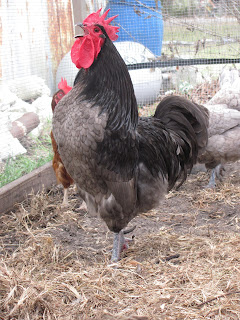Introducing our Marans
We have increased our flock size lately. We are now up to 15 chickens in our coop designed for 12 - 1 Blue Marans rooster, 1 Blue Marans hen, 2 Cuckoo Marans hens, 2 Speckled Sussex hens, 1 Columbian Wyandotte, 1 American Game hen, 1 Barred Plymouth Rock hen, and 6 Rhode Island Red Hens. They are a little cozy at the moment, we'll plan to expand their run at some point in the future. We also have 2 chicks an Amerucana and a Buff Orphington, and 20 Marans eggs in the incubator. Right now Gary's grandfather is selling our eggs along with his garden produce at his roadside stand. The profit I'm putting off to the side, for the purpose of expanding the run. At the rate we are selling eggs, that won't be too long.
Our rooster's name is Marcus Aurelius because he thinks he is a mighty general and emperor of all of Rome. He is a blue Marans. He is about knee high when he streaches out to his full height, and I think he would be a good defender of the flock, if I was letting them free-range. However, he feels the need to run at us through the fence every so often, so we're not going to try that theory. The few times he's gotten out he has been difficult to catch. I would like to try working with him abit after we trim his spurs to see if he is show-bird material. Our Blue Hen is Mia. She's pretty quiet, not boss toward the other hens, though she's obviously up on the pecking order because she's our roo's favorite hen, and no one ever picks on her. She will cause a real ruckus though, if she is separated from her fellow.
 |
| Myrtle top left, Maude right most |
 |
We have two new Cuckoo Marans that we bought March 26th, Myrtle and Maude. They are barred birds similar to the Barred Rock in the middle of the above picture, but they have more spots of white with black around it, than actual bars, as a result it looks more like lacing to me than barring. Like Mia they are pretty quiet birds. I can't yet tell the two apart unless I am looking at their leg bands, but the breed is known for quiet more stand offish hens. Not as personable as the rest of the flock. Though Maude I have discovered hates to be picked up. These two are hatchery stock, but lay a surprisingly dark egg for such. I would like to breed them with our blue roo, and see what sort of color we would get out of them. I've been doing a little reading on chicken genetics, but size there are so many factors in determining color, banding, the diluting gene, etc that can affect color, I haven't made much headway, but I think it would make a portion of the chicks have blue were the black is in the banding. Anyway, now you've met 4 of our flock of 15 and growing.



0 random thoughts